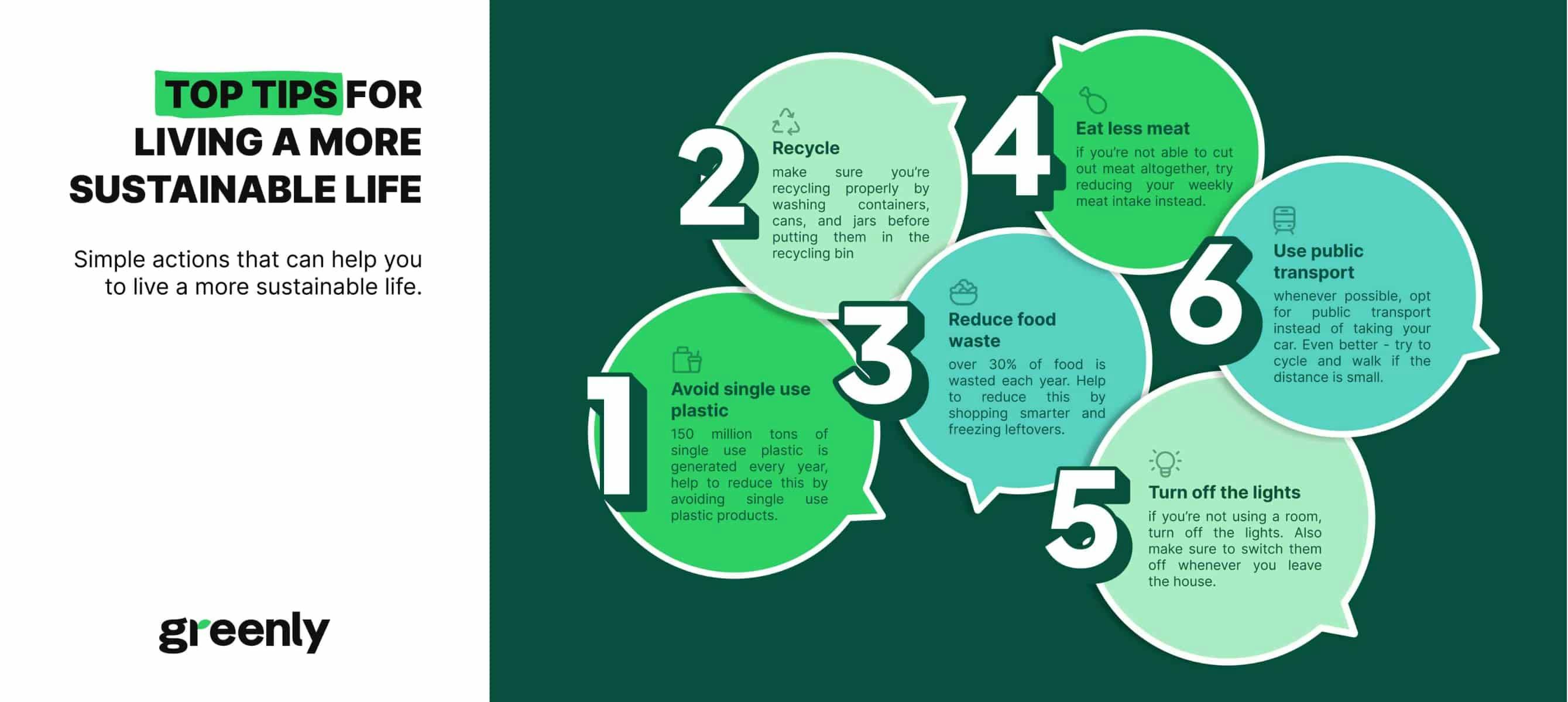
What are the 3 Pillars of Corporate Sustainability?
In this article, we'll explore what the 3 pillars of corporate responsibility are, why they're important, and how businesses can turn them into practical action.
ESG / CSR
Industries



More than ever, it’s imperative to implement any and all sustainable methods possible to create a healthier future and protect the environment – and green living could be the way to do that.
But how can we each strive to protect the environment beyond our habitual habits, like avoiding plastic bags and turning off the lights when we leave a room?
How can green living pave the way for reduced climate change and a better environment for future generations?
In short, green living is a means of developing sustainable habits in one’s daily life so that their daily routines work alongside the resources of nature instead of depleting them, or doing more long-term damage to the environment or ecological system.
The most common way that people become more cognizant of the vital aspects to green living are through the need to reduce pollution, to protect our wildlife from going extinct, and to preserve our conservation of natural resources. Predominantly, people recognise that green living can alleviate the rapidly increasing rates of climate change and global warming.
There are a multitude of benefits to green living.
The obvious benefits of green living include improved sustainability both within individuals and the world, as well as the conspicuous benefit of improving the state of the environment by taking direct action to reduce climate change and global warming.
But there are many pros to committing to green living.
Green living is an easy way to directly reduce your carbon footprint and overall global emissions. By implementing simple habits like reducing your use of plastic or electricity consumption, you immediately make a difference in pollution – even if you can’t see it.
One of the primary components of green living is to make use of what you already have: i.e., the infamous saying of, “reduce, reuse, recycle”.
Another green living trend that grew in popularity due to the pandemic was gardening.
More and more people have decided to grow their own produce at home, and doing so helps reduce both food faste and superfluous use of plastic packaging.
Most Eco-friendly products on the market are becoming cheaper.
So, if you decide to join the green living movement – it’s likely that you’ll notice a decrease in your typical spending habits.
Green living will indirectly improve your diet and overall health, as it will increase your consumption of fruits and vegetables.
The vitamins and nutrients in fruits and vegetables allow our bodies to maintain our overall health and vital functioning. In a world where fast food has become the norm, most do not consume the amount of fruits and vegetables that they should – and green living can help to encourage better eating habits while also saving the planet.
Green living can create a domino effect. If one person see’s how well you’re doing thanks to green living, then they will be inspired to try the same. The fight against climate change is a collective battle, and if we can slowly create change and encourage more sustainable habits – we can strive for a colossal impact and drastically reduce the negative effects of global warming.
Overall, implementing green living is one of the best ways to promote environmental conservation.

There are multiple ways to try and implement green living habits into your daily life.
One of the most common ways to try and be greener is to seek alternatives to fossil fuels that pollute the environment. Fossil fuels create greenhouse gasses that negatively affect the ozone layer and the atmosphere.
My dad used to have a car that ran on vegetable oil! I would know he was home when it smelled like french fries outside the house.
Switching to an electric car can help to reduce the amount of daily pollution you contribute to, or even better and perhaps more affordable – is to opt for public transportation, walking, or ride share services whenever possible.
If you love to travel, odds are – you’re creating a large carbon footprint.
From airplanes, to long car rides – the hospitality industry has been encouraged to adjust their business model to be more Eco-friendly to ensure that travel will remain viable for those who choose to subscribe to green living.
You don’t have to stop traveling if it’s something you enjoy, but there are a few things you can do to cut down on your carbon footprint. For example, you can offset your carbon emissions from your flight by purchasing carbon credits that will later counterbalance your carbon footprint.


Another way to establish green living is to install solar energy panels within your own home. They’re relatively easy to install, and once you do – the maintenance required to maintain solar panels is low. You’ll reduce your electricity bills, electric consumption, and help the environment all at the same time.
Reducing your meat consumption can also benefit the environment. Given the amount of plant-based options on the market, especially in the U.S. – eating plant based has never been easier.
Opt for meatless Mondays, or aim to purchase Eco-friendly animal products if necessary – like cage-free eggs or kosher livestock.
Fast Fashion is harming the environment through its extensive industrialization and unsustainable materials that aren’t biodegradable. Therefore, another way to practice green living is to subscribe to sustainable fashion to reduce wasting resources and promote equal rights and fair labor practices in the industry.
You can practice green living with your clothing choices by purchasing second hand clothing, local and eco-friendly clothing businesses, or donating and re-selling your own clothes after you’ve outgrown them to encourage reusing garments to their maximum potential.
A final example of green living is to make your own home more sustainable. This can be done by investing in eco-friendly furniture, more efficient equipment like energy efficient dishwashers, washing machines, and dryers to reduce your carbon footprint.

Green living absolutely helps to prevent further climate change!
Green living is a way to directly reduce the negative impacts of climate change as it encourages individuals to reduce their own carbon footprint, which collectively – can help reduce global temperatures.
Green living not only allows you to improve the health and sustainability within your own life, but it also helps pave the pathway for a brighter future for life on Earth.
The truth is, if everyone chose to live a more sustainable lifestyle by implementing green living into their daily lives, then global warming would be much less of a cause of concern.
So, why don’t people choose green living?
Well, green living can seem daunting to most people at first. Small habits could seem inconvenient or a nuisance: like remembering to bring reusable shopping bags when grocery shopping, the extra time to clean a reusable water bottle or dishware in place of plastic, or remembering to unplug all stationary devices before leaving the house.
Especially in the world we live in today, where instant gratification is so easily accessible at our fingertips with social media, news, and text messaging – it’s hard for people to see the greater picture in how taking the time to change their small actions could ultimately contribute to a globally efficacious result: improvement on the global predicament of climate change.
Therefore, that is the ultimate obstacle of green living – is the added effort and time, even if it’s not substantial, that one would need to take to adjust their habits to comply with the notions of green living.
For instance, let’s say that you really care about marine life.
If you care about marine life, creating a green living habit that you can stick to that ties back to the importance of ocean life suffering will help the new habit become both feasible to maintain and sustainable. You could opt to use biodegradable containers instead of traditional plastic to ensure that you aren’t contributing to the mass amount of plastic in the ocean.
Another example is if you have children. Parents often have an innate instinct to leave a world behind that is better for their children. So, if you have kids – a great way to promote green living is to instill those sustainable living habits within your own children from a young age so that they take it into their adulthood and can continue to make an environmental difference.
Demonstrating the importance of green living to your own children can help build a better future and allow them to live healthier lives, and even better – they can eventually encourage their friends and family who didn’t grow up with the same values to try out the benefits of green living as well.
If establishing green living habits into your life is really difficult, but you still want to – another great way to kick start your green living journey is to buddy up with a friend and create those green living habits together.
Think of it this way: you know how they say it’s good to have a gym buddy to be held accountable for your fitness goals and stay motivated?
The same can be said for your new green lifestyle. It might be easier to stick to your goals if you have a friend trying to achieve the same new environmental habits as you. You can text and check in with each other if you’re really using that new reusable water bottle, or take the metro to your next yoga class together.
Having a lifestyle that pertains to green living doesn’t have to be difficult – all it takes at the end of the day is a little more effort and thought into your small, daily habits to cultivate a more Eco-friendly lifestyle to help improve the environment.
You don’t have to be a big shot investor or CEO of a company to make a difference in the fight against climate change. In fact, aiming to reduce your carbon footprint in little ways is one of the biggest things anyone can do to help mitigate further climate change.
We hope this post encourages you to implement more mindful habits to improve sustainability both globally and within your own life.

If reading this article about green living has made you interested in reducing your carbon emissions to further fight against climate change – Greenly can help you!
For a deeper understanding of product impact, check out Life Cycle Analysis
Greenly can help you make an environmental change for the better, starting with a carbon footprint assessment to know how much carbon emissions your company produces.
Click here to learn more about Greenly and how we can help you reduce your carbon footprint.
Request a free and non-binding demo with one of our experts today and find the solution that best fits your business needs.